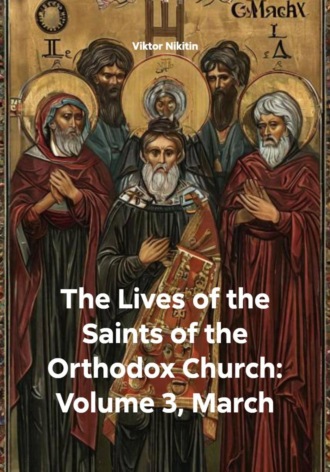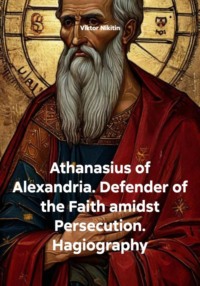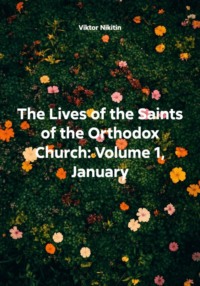
Полная версия
The Lives of the Saints of the Orthodox Church: Volume 3, March
Holy 9 Martyrs of Georgia (Nine Brothers Kherkheulidze) at Marabda (1625) (see also August 3):
The Nine Brothers Kherkheulidze were noble Georgian warriors who fought bravely against invading forces at the Battle of Marabda. Choosing death over renouncing Christianity, their martyrdom galvanized Georgian resistance and faith. Their sacrifice remains a touchstone of national and spiritual identity.
Virgin-martyr Martha Kovrova and Martyr Michael Stroeva (1938):
During the cruel Soviet persecutions, Martha Kovrova and Michael Stroeva courageously upheld their Christian faith despite threats and torture. Their involvement in secret Christian communities led to their arrest and execution. Their witness shines as a beacon of hope and resilience amid twentieth-century oppression.
Other Commemorations:
Synaxis of the Volokolamsk Icon of the Most Holy Theotokos (1572):
This feast honors the miraculous icon of the Mother of God revered in Volokolamsk, Russia. The icon is famed for protecting the faithful from invasions and plagues, and numerous healings are attributed to its intercession.
Commemoration of Job Boretsky, Metropolitan of Kiev, Galicia and All-Rus' (1620–1631):
Metropolitan Job was a defender of Orthodox faith and culture during a time of religious and political upheaval. He worked tirelessly to educate clergy and laity, strengthen monasticism, and maintain the unity of the Orthodox Church in Eastern Europe.
Commemoration of Grigory Lisovsky, Metropolitan of Poltava (1927):
Metropolitan Grigory shepherded his flock amid early Soviet hostility. Revered for his pastoral care and unwavering faith, he became a symbol of spiritual perseverance in the face of persecution.
* * *
The Lives of the Saints Celebrated on March 4
Saint Julian of Alexandria, Bishop of Alexandria (189)
Saint Julian served as Bishop of Alexandria during the early years of Christianity when the Church was still forming its identity amidst frequent external opposition. Known for his pastoral zeal and theological wisdom, Julian courageously guided his flock through persecution and internal challenges. He was a defender of orthodoxy, actively opposing heretical teachings that threatened the unity of the Church. His episcopacy is remembered for the fostering of faith, charitable works, and strengthening the Christian community in Egypt’s largest city. Though details of his martyrdom are scarce, his life set a pattern of episcopal courage and holiness.
Martyrs Paul and his sister Juliana, and Quadratus, Acacius, and Stratonicus, at Ptolemais in Egypt (273)
Paul and Juliana were siblings united not only by blood but by a profound faith in Christ. Alongside their companions Quadratus, Acacius, and Stratonicus, they lived in Ptolemais during a period of intense pagan hostility toward Christians. These martyrs were arrested for their refusal to sacrifice to Roman gods. Despite severe tortures – including beatings, starvation, and imprisonment – they remained steadfast, encouraging one another and strengthening the faith of fellow believers. Their shared martyrdom, especially that of siblings Paul and Juliana, exemplifies familial solidarity in witness and the power of faith to overcome fear.
Venerable Gerasimos of the Jordan (475)
Saint Gerasimos was a desert monk whose life became a beacon of holiness and asceticism in the wilderness near the Jordan River. Renouncing worldly comforts, he founded a monastery where he and his disciples pursued rigorous fasting, prayer, and solitude. Gerasimos was especially known for his gentle nature and extraordinary compassion for all creation – stories tell of his kindness toward wild animals, including a legendary encounter with a lion whom he tamed and befriended. His miracles of healing and spiritual guidance drew many to the desert in search of sanctity. Gerasimos’ life embodies the desert tradition’s pursuit of union with God through ascetic struggle and love.
Saint Gregory of Constantius in Cyprus, Bishop
Although historical records are limited, Saint Gregory is remembered as a devoted shepherd of the Church in the town of Constantius on the island of Cyprus. His episcopate was marked by pastoral care, courage in the face of local opposition, and efforts to cultivate Christian unity and orthodoxy. He is commemorated for his humility, wisdom, and unwavering commitment to his flock, embodying the virtues of a faithful bishop in a challenging era.
Saint James the Faster, of Phoenicia, Syria (6th century)
Saint James earned his title "the Faster" through an extreme ascetic lifestyle marked by continual fasting, prayer, and vigil. Living in the region of Phoenicia, he was renowned for his spiritual insight and miracles, including healing the sick and casting out demons. His austere life inspired many to repentance and holiness. Saint James' fasting was not mere physical abstinence but a spiritual discipline aimed at purifying the heart and drawing nearer to God.
Saint Lucius I, Pope of Rome (253)
Saint Lucius I became Pope during the turbulent period of Emperor Decius’ reign, known for its violent persecution of Christians. Almost immediately after his election, Lucius was exiled for refusing to renounce his faith or compromise with pagan authorities. Even in exile, he continued to exercise his pastoral ministry by letter and prayer, strengthening Christians facing martyrdom and hardship. His courage and unwavering fidelity made him a symbol of steadfast leadership, guiding the Roman Church through one of its darkest hours. He is remembered as a confessor who bore suffering for Christ without yielding.
Martyrs of Rome, buried in the Catacombs of Callistus on the Appian Way (260)
The Catacombs of Callistus became a sacred resting place for many Christians who suffered under the brutal persecutions of Emperor Valerian and his prefects. Approximately 900 martyrs, many anonymous, were interred there, their bones bearing silent witness to faith tested by torture, imprisonment, and death. Their stories, passed down through early Church tradition, tell of families torn apart, prisoners encouraging one another, and believers who faced lions, the sword, and fire without renouncing Christ. The catacombs themselves symbolize the early Church’s strength in community and hope in resurrection, sanctified by the blood of so many faithful.
Saint Leonard of Avranches, Bishop of Avranches (c. 614)
Saint Leonard was renowned for his deep compassion, especially for prisoners and the poor. As Bishop of Avranches in Normandy, France, he dedicated himself to pastoral care and social reform, often intervening on behalf of captives and advocating for their release. His influence extended beyond spiritual matters; he stood against corruption and injustice, inspiring noble and common folk alike. Numerous miracles of healing and deliverance were attributed to his intercession, cementing his reputation as the patron saint of prisoners and captives throughout Western Europe.
Saint Owen of Lastingham (Owin), Monk of Lichfield, Disciple of Saint Etheldreda (c. 680)
A disciple of the famous abbess Saint Etheldreda, Owen embraced the monastic life with zeal. He is credited with founding or reforming several monastic communities in northern England, including Lastingham, where he became abbot. Known for his gentle spirit, Owen was also a gifted spiritual guide and healer, often sought for counsel and prayer. His leadership helped establish Christian monasticism in the region during the early Anglo-Saxon period, blending Celtic and Roman traditions.
Saint Basinus, Monk and Abbot of St Maximin in Trier, Germany (c. 705)
Saint Basinus began as a monk at the influential monastery of St Maximin in Trier before rising to become its abbot and eventually the bishop of Trier. His tenure was marked by pastoral care, theological learning, and efforts to strengthen the Church amid the political upheavals of the time. Known for his humility and wisdom, Basinus was respected by both clergy and laity. He is remembered for his commitment to monastic reform and education.
Saint Appian, Monk at the Monastery of St Peter of Ciel d'Oro in Pavia, Hermit in Comacchio (c. 800)
Saint Appian first lived in community at the monastery of St Peter of Ciel d'Oro, known for its strict observance of monastic discipline. Later, he chose the solitary life of a hermit in the marshes of Comacchio, where he labored to bring the light of Christ to a remote and spiritually impoverished region. His preaching and example led many local inhabitants to embrace Christianity. He is honored as a pioneer missionary who combined the monastic call to prayer with active evangelism.
Saint Adrian of May and Companions (c. 875)
Bishop Adrian shepherded the Christian community on the Isle of May in the Firth of Forth, Scotland, along with monks such as Stalbrand, Geodianus, Caius, and Clodian. Their peaceful monastic life was violently interrupted by Viking raids. Refusing to abandon their faith or island, they were captured and martyred by the Danes for their steadfast confession of Christ. Their collective martyrdom inspired generations of Scottish Christians, symbolizing courage and fidelity amid pagan oppression.
Saint Felix of Rhuys, Monk at Fleury Abbey, France (1038)
Saint Felix was a monk at the famous Fleury Abbey before founding a new monastic community at Rhuys in Brittany. Renowned for his humility, devotion, and strict adherence to the Rule of Saint Benedict, he cultivated a community dedicated to prayer, work, and hospitality. His leadership helped spread monastic reform and spiritual renewal throughout medieval France.
Saint Gregory, Bishop of Assos near Ephesus (1150)
As bishop of Assos, a city near the ancient center of Ephesus, Saint Gregory was a vigilant pastor who defended the Orthodox faith against heresy and schism. Known for his deep spirituality and commitment to his flock, he fostered monastic life and encouraged theological education. His episcopal service strengthened the Church in Asia Minor during a period of political instability.
Venerable Gerasimus, Monk of Vologda (1178)
Saint Gerasimus was a Russian monk whose ascetic life in the forests of Vologda became a model of prayerful solitude and spiritual guidance. Renowned for his humility and gift of healing, he became a spiritual father to many seeking repentance and renewal. His legacy is preserved in Russian monastic tradition, emphasizing hesychasm (inner stillness) and obedience.
Blessed Basil (Basilko), Prince of Rostov (1238)
Prince Basilko renounced worldly power to defend Orthodoxy in turbulent times marked by Mongol invasions. Despite his noble rank, he was humble and generous to the poor, supporting the Church and monasteries. His life blended princely duty with deep personal sanctity, and he is venerated as a protector of faith and homeland.
Saints of Pskov Martyred by the Latins (1299): Saint Ioasaph of Snetogorsk Monastery and Saint Basil of Mirozh Monastery
During the invasions and occupations of Pskov by Western forces, these monks remained unwavering in their Orthodox faith. Refusing to abandon their spiritual duties or submit to foreign religious authorities, they were tortured and killed. Their martyrdom exemplifies the defense of Orthodoxy in Russia against external aggression.
Saint Daniel of Moscow, Great Prince, Wonder-worker (1303)
Founder of the principality of Moscow, Saint Daniel combined political leadership with deep piety. He fostered the construction of churches and monasteries, supported the Orthodox Church against heresy, and was known for acts of mercy and justice. Numerous miracles followed his death, and he is revered as the spiritual father of Moscow’s rise.
Saint Peter (Michurin), Youth of Tobolsk (Peter of Tomsk) (1820)
Peter Michurin was known for his pure and devout life despite his youth. Living in Siberia, he maintained a strong Christian witness through prayer, charity, and obedience. His premature death did not diminish his legacy as a model of youthful holiness and dedication to Christ in harsh conditions.
New Hieromartyr Michael Kargopolov, Priest of Krasnoyarsk (1919)
Father Michael served during the early years of Soviet repression, steadfastly ministering to his flock despite threats and violence. Arrested for refusing to cooperate with atheist authorities, he endured interrogation and torture before being executed. His martyrdom is remembered as part of the broader witness of the Russian Church under persecution.
New Hieromartyr Dimitry Ivanov of Kiev, Archpriest (1933)
Archpriest Dimitry was a spiritual leader who refused to betray his flock or faith during the brutal Soviet campaigns against religion. His imprisonment and execution made him a symbol of pastoral courage and fidelity to the Church in the face of overwhelming oppression.
New Hieromartyr Vyacheslav Leontiev of Nizhegorod, Priest (1937)
Vyacheslav continued to minister underground, celebrating the Divine Liturgy and administering sacraments despite the risk of death. Arrested and executed during Stalin’s purges, his steadfastness remains an inspiration for persecuted clergy and laity.
New Martyr John of Al-Sindiyana (Palestine) (1937)
John was a lay Christian martyred in Palestine during waves of anti-Christian violence. His faithfulness under pressure encouraged others to maintain hope and courage despite political and religious turmoil.
New Hieromartyr Alexander, Priest (1938)
Father Alexander served faithfully until his arrest and execution during the Great Terror. His refusal to renounce his vocation or betray others marks him among the countless new martyrs of the Soviet era who bore witness to Christ even unto death.
Other Commemorations:
Translation of the relics (938) of Martyr Wenceslaus (Vyacheslav), Prince of the Czechs (935): The solemn moving of the relics of this noble martyr, a prince renowned for his piety and defense of Christian lands against pagan forces, renewed devotion across Central Europe and bolstered Christian identity among the Czech people.
Repose of Schemamonk Mark of Glinsk Hermitage (1893): Known for his ascetic rigor and spiritual counsel, Mark inspired many monastics and laypeople alike in the Russian Glinsk tradition.
Commemoration of Staretz Theodosius of Pochaev (Feodosiy Pochayivsky) (1906): A renowned elder and wonderworker, Staretz Theodosius guided countless souls with prayer and counsel, his life marked by humility and miracles.
Repose of Schemanun Agnia, Eldress of Karaganda (1976): Living through Soviet persecution, Agnia’s steadfast faith and spiritual guidance nurtured the underground Church in Central Asia.
* * *
Lives of the Saints Celebrated on March 5
Martyr Conon of Isauria (1st century):
Saint Conon hailed from Isauria, a wild and mountainous region in Asia Minor known in antiquity for its fierce and independent peoples. Conon lived during the earliest centuries of Christianity, at a time when the faith was illegal and Christians were subjected to brutal persecution under the Roman Empire. He was a man of deep faith and unwavering courage, refusing to worship pagan gods or offer sacrifices to the emperor. Arrested for his steadfast confession of Christ, Conon endured severe torture but remained unshaken. Tradition recounts that he performed miracles even in prison, healing fellow prisoners and converting some jailers. Ultimately, he was sentenced to death by beheading. His martyrdom is remembered as a shining example of fidelity to Christ in the face of worldly power.
Martyr Nestor, Father of Martyr Conon of Isauria:
Nestor, the father of Saint Conon, is venerated not only for his own martyrdom but also for the spiritual heritage he passed to his son. Though details about his life are sparse, Nestor’s faith was clearly instrumental in shaping Conon’s courage and dedication. According to tradition, Nestor too was arrested and tortured for refusing to renounce Christianity. The story of this father and son pair reveals the powerful witness of Christian families who preserved and handed down the faith through generations during times of persecution.
Martyr Onisius (Onesimus) of Isauria, by Beheading (1st century):
Onisius, sometimes called Onesimus, was a contemporary of Conon and Nestor, also from Isauria. Like many early Christians, he suffered under Roman persecution for his refusal to abandon Christ. Arrested and condemned to death, Onisius faced his execution with peaceful resolve, encouraging fellow believers to remain faithful. His martyrdom by beheading symbolizes the triumph of faith over fear and worldly threats, a recurring theme in early Christian witness.
Saint Theophilus, Bishop of Caesarea in Palestine (ca. 200):
Saint Theophilus was a distinguished bishop of Caesarea, one of the main cities in Palestine and a prominent center of early Christian life. Known for his pastoral care and theological wisdom, Theophilus shepherded his flock through difficult times when Christians faced hostility from both pagan authorities and internal heresies. He is especially remembered for his opposition to early heretical teachings and for strengthening the Christian community through teaching, prayer, and charity. His episcopate was marked by personal humility and a deep commitment to the truth of the Gospel.
Martyr Conon the Gardener, of Pamphylia (251):
Conon was a humble gardener living in Pamphylia, in the southern region of Asia Minor. Despite his simple profession, he was renowned for his deep Christian faith and his gift of healing. When the Decian persecution swept through the region, Conon openly declared himself a Christian and refused to sacrifice to the Roman gods. Arrested, he endured brutal tortures, but he remained serene and faithful, encouraging other prisoners and converting many by his example and miracles. After being beheaded, his relics became a source of healing and blessing for the faithful, and he is often invoked as a protector of laborers and gardeners.
Martyrs Archelaus, Kyrillos, Photios, Virgin-martyr Irais (Rhais) of Antinoë, and 152 Martyrs in Egypt (ca. 308):
This remarkable group suffered martyrdom in Antinoë, Egypt, during the fierce Diocletian persecution—the last and most severe imperial persecution of Christians in the Roman Empire. Among the group were the soldiers Archelaus, Kyrillos, and Photios, as well as the virgin martyr Irais (sometimes called Rhais). Despite facing torture and death, they all held firm in their faith, refusing to deny Christ. Their martyrdom was widely witnessed and recorded, inspiring the Egyptian Church for centuries. The presence of so many martyrs at one time highlights the intensity of the persecution and the extraordinary resilience of the Christian community in Egypt.
Venerable Conon of Cyprus (4th century):
Saint Conon lived as an ascetic and monk in Cyprus during the 4th century, a time when monasticism was spreading throughout the Eastern Roman Empire. He was known for his extreme humility, patience, and ceaseless prayer. Conon’s life was marked by spiritual struggles and victories, and many miracles are attributed to his prayers—healings and deliverances from evil. He lived in solitude yet was sought after by many for spiritual guidance. His example helped shape the monastic tradition in Cyprus and remains a beacon for those seeking to live the Gospel in holiness.
Martyr Eulogius of Palestine:
Though less is known of his life, Saint Eulogius bore witness to Christ in Palestine by refusing to apostatize during pagan persecutions. His steadfastness in faith, despite suffering and ultimate martyrdom, is commemorated with reverence. His name, meaning “well-spoken,” reflects the spiritual fruits of his testimony.
Martyr Eulampius of Palestine, by the Sword:
Eulampius, likewise martyred in Palestine, suffered death by the sword for confessing Christ. He is honored among the many early martyrs who offered their lives to the Lord rather than deny Him. His witness is a reminder of the cost of discipleship and the eternal reward for those who remain faithful.
Venerable Mark the Ascetic of Egypt (Mark the Athenian, Mark the Faster) (5th century):
Saint Mark was a monk of remarkable ascetic rigor who lived in the Egyptian deserts. Often called “Mark the Athenian” due to his Greek origin, he embraced a life of fasting, prayer, and solitude. His spiritual writings on asceticism, humility, and watchfulness remain influential, providing guidance to generations of monks and lay Christians alike. Mark’s teachings emphasize the struggle against passions and the purification of the heart through continuous prayer, making him a key figure in Orthodox spiritual tradition.
Saint Hesychius the Faster, of Bithynia (790):
Hesychius was a monk in Bithynia (modern-day Turkey) renowned for his extraordinary fasting and deep contemplative prayer. Living in the tradition of the hesychasts, those who pursue inner stillness and the Jesus Prayer, he was known for miracles and spiritual insight. Hesychius’ life shows the ideal of monastic withdrawal from worldly distractions in order to unite with God in silence and purity of heart.
Saint Oliva of Brescia, Martyred in Brescia, Italy (under Emperor Hadrian, 138):
Saint Oliva was a young woman in northern Italy who embraced Christianity during the reign of Emperor Hadrian. When the authorities began persecuting Christians, she was arrested for refusing to renounce her faith. Despite threats, imprisonment, and torture, Oliva’s courage never wavered. She was eventually put to death, her martyrdom strengthening the Christian community in Brescia and inspiring many converts.
Saint Eusebius, Abbot of Bethlehem, Born in Cremona, Italy:
Born in Cremona, Italy, Saint Eusebius later moved to Bethlehem, where he became abbot of a monastery. He was a defender of orthodox Christian teaching and a vocal opponent of Origenism, a theological error that distorted key doctrines. Through his writings, prayers, and leadership, Eusebius helped maintain the purity of Christian doctrine during troubled theological times. His legacy lives on in the monasteries of the Holy Land.
Saint Eusebius and Companions, Martyrs of North Africa:
This group of ten martyrs suffered in North Africa, likely during Roman persecutions in the 3rd or 4th centuries. Though their individual stories have been lost, they collectively represent the courage and endurance of the Church in Africa, which became a vibrant center of Christian life and martyrdom.
Saint Colman of Armagh, Disciple of Saint Patrick (5th century):
Saint Colman was one of the early Irish Christians who learned from Saint Patrick himself. He devoted his life to spreading the Gospel across Ireland and to nurturing the young Church. Known for his humility and asceticism, he helped establish monastic centers and played a key role in Ireland’s Christianization.
Saint Kieran of Saighir (Ciaran of Ossory), Confessor (c. 530):
Saint Kieran is counted among the Twelve Apostles of Ireland, the first wave of Irish monks and missionaries. Founder of the monastery at Saighir, he was a prominent teacher and confessor, guiding many in the Christian faith. His influence extended across Ireland, and his monastery became a renowned center of learning and holiness.
Saint Carthage the Elder, Bishop of Ossory (c. 540):
Successor to Saint Kieran, Carthage the Elder continued the evangelization and pastoral care of the Irish Church in Ossory. His leadership was marked by wisdom and holiness, fostering the growth of monastic life and the consolidation of the Christian faith in Ireland.
Saint Caron, Patron of Tregaron, Dyfed, Wales:
Saint Caron is honored in the Welsh town of Tregaron, where a church bears his name. Though historical records are limited, he is traditionally believed to have been an early Christian missionary in Wales, instrumental in spreading Christianity in the region and living a life of holiness.
Saint Piran of Padstowe (Pyran), Monk of Perranporth (6th century):
Saint Piran is one of the most beloved saints of Cornwall and is considered the patron saint of tin miners. A monk who came from Ireland or Wales, he is credited with spreading Christianity across Cornwall, establishing churches and monasteries. Legends say he discovered how to smelt tin, making him a symbol of faith and local identity. His feast is celebrated with great devotion in Cornwall.











